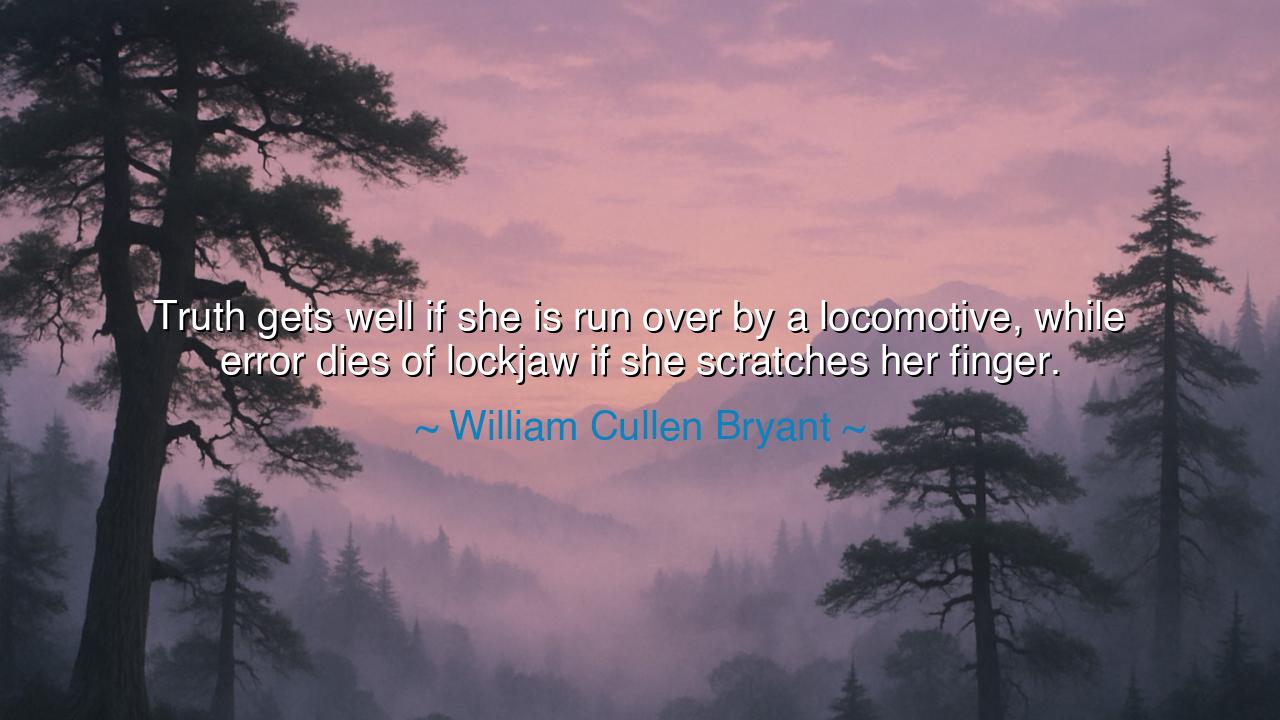
Truth gets well if she is run over by a locomotive, while error
Truth gets well if she is run over by a locomotive, while error dies of lockjaw if she scratches her finger.






William Cullen Bryant, poet of America’s early voice and steadfast guardian of moral conviction, once proclaimed: “Truth gets well if she is run over by a locomotive, while error dies of lockjaw if she scratches her finger.” In this vivid image he contrasts the enduring vitality of truth with the fragility of falsehood. For truth, though it may be crushed under the heaviest forces of denial, persecution, or mockery, always rises again, renewed and unbroken. Error, on the other hand, is weak at its core; it cannot survive the smallest wound, for it is born of shadow and destined for decay.
The origin of this thought lies in Bryant’s life as a poet, editor, and statesman in nineteenth-century America. He lived through political storms, moral debates, and the struggles of a young nation seeking its soul. As a man of letters and principles, he witnessed firsthand how lies, though loud and destructive in their moment, quickly collapsed under their own weakness, while truths—about liberty, justice, and dignity—outlasted every assault. His metaphor of the locomotive and the scratch captures this eternal contrast: truth’s resilience and error’s fragility.
History itself confirms his words. Consider Galileo Galilei, condemned and silenced by the power of the Church for declaring that the earth moved around the sun. For a time, truth lay as though crushed beneath the locomotive of authority. Yet centuries later, truth rose unbroken, shining brighter than ever, while the error of geocentrism faded into dust. Or think of slavery, defended for centuries by falsehoods about race and humanity. That lie could not endure; it fractured under its own contradictions, while the truth—that all men are created equal—survived war, death, and hatred, and continues to march forward.
Bryant’s metaphor also reminds us of the paradoxical strength of truth: it does not require protection to survive. Truth can be maligned, suppressed, even denied by entire generations, yet it possesses an inner vitality that ensures its return. Lies, however, are brittle. They may shout with arrogance, but they carry within themselves the seeds of their own destruction. A single question, a small exposure, a tiny crack, and the edifice of falsehood collapses. As Bryant says, error dies of lockjaw at the smallest wound, unable to withstand even a scratch.
The meaning of this insight is also heroic. It tells us that those who defend truth need not despair when it seems to suffer defeat. Appearances deceive. Truth may fall in battle, but it is immortal; falsehood may seem victorious, but it is mortal, fragile, and fleeting. Those who cling to error must work endlessly to protect it, for it cannot endure even the lightest test. But those who walk with truth, though they face hardship, walk with eternity.
The lesson for us is to trust in the power of truth, even when it seems crushed beneath the weight of opposition. Do not be disheartened when lies appear to triumph for a season, for they are destined to wither. Instead, align yourself with truth, even when it costs you, for what is wounded will heal, and what is crushed will rise again. Remember: time itself is the great physician of truth, but time is the executioner of falsehood.
Practically, this means living with courage and integrity. Speak truth even when mocked, and seek truth even when uncomfortable. Do not fear that honesty will perish under ridicule or suppression. Know instead that every step taken in truth is eternal, while every step in error is fleeting. And when confronted by lies, remember that they cannot endure long; even the smallest scratch may bring them down.
Thus Bryant’s words endure as a call to courage: “Truth gets well if she is run over by a locomotive, while error dies of lockjaw if she scratches her finger.” Let us take heart from this eternal contrast. For though lies may roar and truth may stumble, in the end, truth will rise, radiant and unbroken, while error, fragile and feeble, vanishes like smoke in the wind.






OCNguyen son Toan Official Channel
This quote seems to convey the idea that truth, no matter how badly it is mistreated, can recover and continue to exist, while error is vulnerable to even the slightest adversity. Is it possible that in today's world, the lines between truth and error are often blurred, and the persistence of error can feel as if it's just as strong as truth? How can we navigate this tension, especially in an era of misinformation?
MHPhan Minh Huy
The metaphor of truth being run over by a locomotive and error dying from a scratch is vivid and thought-provoking. Does this mean that truth, no matter how battered or challenged, will ultimately prevail, while even minor falsehoods are doomed to fail? But isn't it also true that sometimes lies seem to spread and persist more easily? Maybe Bryant is referring to the ultimate outcome, where truth prevails in the long run despite temporary setbacks.
GDGold D.dragon
This quote strikes me as a metaphor for how we often treat truth and error in society. Truth, despite facing significant challenges, often survives and comes out stronger, while lies, even when small, can crumble quickly under scrutiny. Is Bryant saying that truth has an unshakable foundation, or is he merely pointing out that our collective acceptance of truth can make it indestructible over time, despite setbacks?
MLVo Thi My Linh
Bryant's quote seems to suggest that truth has an inherent resilience, while error is fragile. But does this really hold true in all situations? Sometimes, it feels like falsehoods persist, gaining momentum, while truths are buried under the weight of misinformation. Could the survival of truth really depend on something as dramatic as a locomotive, or is it more about the relentless pursuit of truth by those who seek it?